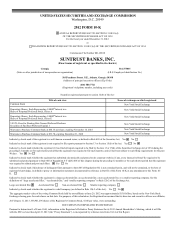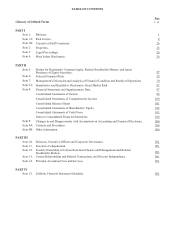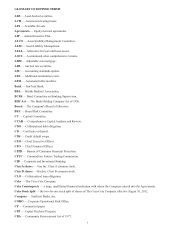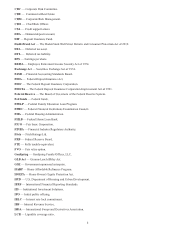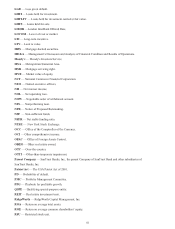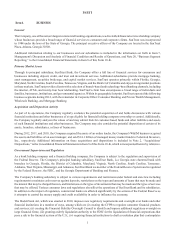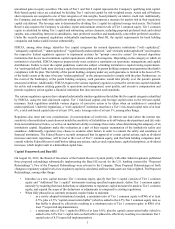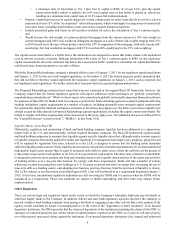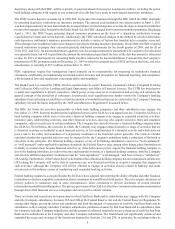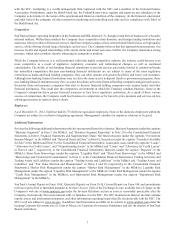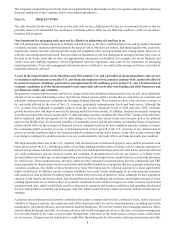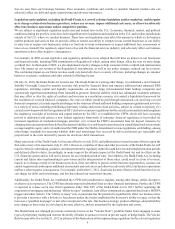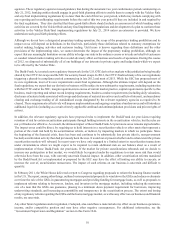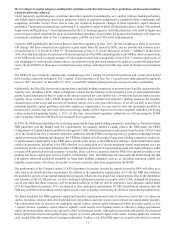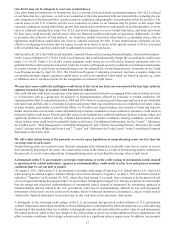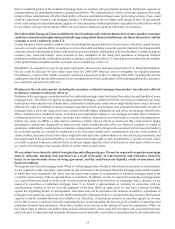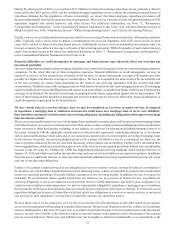SunTrust 2012 Annual Report Download - page 21
Download and view the complete annual report
Please find page 21 of the 2012 SunTrust annual report below. You can navigate through the pages in the report by either clicking on the pages listed below, or by using the keyword search tool below to find specific information within the annual report.5
depositors, along with the FDIC, will have priority in payment ahead of unsecured, nondeposit creditors, including the parent
bank holding company, with respect to any extensions of credit they have made to such insured depository institution.
The FDIC insures deposits accounts up to $250,000. It provides this insurance through the DIF, which the FDIC maintains
by assessing depository institutions an insurance premium. The amount each institution was assessed prior to April 1, 2011
was based upon statutory factors that include the average balance of insured deposits as well as the degree of risk the institution
poses to the insurance fund. Pursuant to the Dodd-Frank Act, the FDIC changed how it assesses insurance premiums. Beginning
April 1, 2011, the FDIC began assessing deposit insurance premiums on the basis of a depository institution's average
consolidated net assets and not its deposits. Additionally, the FDIC introduced changes to the method by which it determines
each depository institution's insurance premium rate to include a variety of factors that translate into a complex scorecard.
These changes were in addition to previous changes related to pre-funding insurance premiums. In late 2009, the FDIC required
insured institutions to prepay their estimated quarterly risk-based assessments for the fourth quarter of 2009, and for all of
2010, 2011, and 2012. An insured institution's quarterly risk-based deposit insurance assessment will continue to be calculated
on a quarterly basis, but will be paid from the amount the institution prepaid until the later of the date that amount is exhausted
or June 30, 2013, at which point any remaining funds would be returned to the insured institution. Consequently, the Company's
prepayment of DIF premiums made on December 29, 2009 resulted in a prepaid asset of $925 million at that time, and after
amortization, is currently at $173 million at December 31, 2012.
FDIC regulations require that management report annually on its responsibility for preparing its institution's financial
statements, establishing and maintaining an internal control structure and procedures for financial reporting, and compliance
with designated laws and regulations concerning safety and soundness.
The Dodd-Frank Act created the CFPB, which is separated into five units: Research, Community Affairs, Complaint Tracking
and Collection, Office of Fair Lending and Equal Opportunity, and Office of Financial Literacy. The CFPB has broad power
to adopt new regulations to protect consumers, which power it may exercise at its discretion and so long as it advances the
general concept of the protection of consumers. In particular, such regulations may further restrict the Company's banking
subsidiary from collecting overdraft fees or limit the amount of overdraft fees that may be collected by the Company's banking
subsidiary beyond the limits imposed by the 2009 amendments to Regulation E discussed below.
The BHC Act limits the activities permissible in which bank holding companies and their subsidiaries may engage. On
November 12, 1999, financial modernization legislation known as the GLB Act was signed into law. Under the GLB Act, a
bank holding company which elects to become a financial holding company may engage in expanded securities activities,
insurance sales, underwriting activities, and other financial activities, and may also acquire securities firms and insurance
companies, subject in each case to certain conditions. The Company has elected to become a financial holding company under
the GLB Act. Nevertheless, the activities in which the Company may engage remain limited to a range of activities that are
(i) financial in nature or incidental to such financial activity, or (ii) complimentary to a financial activity and which does not
pose a risk to the safety and soundness of a depository institution or the financial system generally. The GLB Act further
regulated whether the expanded activities may be engaged in by the Company's subsidiary bank, a subsidiary of the bank or
elsewhere in the enterprise. If a financial holding company or any of its banking subsidiaries cease to be “well capitalized”
or “well managed” under applicable regulatory standards, the Federal Reserve may, among other things, place limitations on
its ability to conduct these broader financial activities or, if the deficiencies persist, require the financial holding company to
divest the banking subsidiary. In order to become and maintain its status as a financial holding company, both the Company
and all of its affiliated depository institutions must be “well-capitalized,” “well-managed,” and have at least a "satisfactory"
CRA rating. Furthermore, if the Federal Reserve determines that a financial holding company has not maintained a satisfactory
CRA rating, the Company will not be able to commence any new financial activities or acquire a company that engages in
such activities, although the Company will still be allowed to engage in activities closely related to banking and make
investments in the ordinary course of conducting such expanded banking activities.
Federal banking regulators, as required under the GLB Act, have adopted rules limiting the ability of banks and other financial
institutions to disclose nonpublic information about consumers to nonaffiliated third parties. The rules require disclosure of
privacy policies to consumers and, in some circumstances, allow consumers to prevent disclosure of certain personal
information to nonaffiliated third parties. The privacy provisions of the GLB Act affect how consumer information is transmitted
through diversified financial services companies and conveyed to outside vendors.
There are limits and restrictions on transactions in which SunTrust Bank and its subsidiaries may engage with the Company
and other Company subsidiaries. Sections 23A and 23B of the Federal Reserve Act and the Federal Reserves' Regulation W,
among other things, govern the terms and conditions and limit the amount of extensions of credit by SunTrust Bank and its
subsidiaries to the Company and other Company subsidiaries, purchases of assets by SunTrust Bank and its subsidiaries from
the Company and other Company subsidiaries, and the amount of collateral required to secure extensions of credit by SunTrust
Bank and its subsidiaries to the Company and other Company subsidiaries. The Dodd-Frank Act significantly enhanced and
expanded the scope and coverage of the limitations imposed by Sections 23A and 23B, in particular, by including within its


